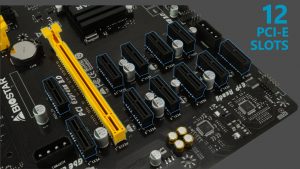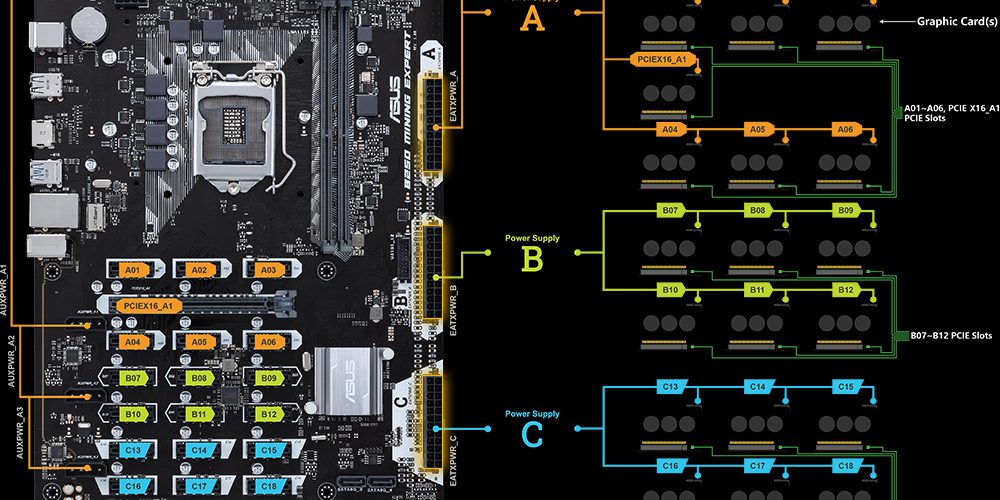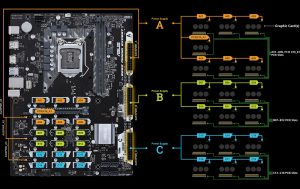Background
Mining creates some interesting options for motherboard design. Historically miners looked for “traditional” PC motherboards that happened to have 6 or 7 PCIe slots and allowed us to connect upto that many GPUs. In those days we needed to make sure that the motherboards BIOS would recognize that many GPUs. We also needed to ensure that it supported the “above 4G” BIOS option. These days those issue seems mostly addressed. But after the growth in mining in 2017 we say many manufactures introduce motherboards specifically for miners. Manufactures like the ASUS and BioStar jumped on this band-wagon with the good products. While these boards allowed us to run 12-19 GPUs on one board, they still used traditional PCIe slots for this. We also saw some Chinese made boards that had even more innovative designs. Like 12 GPUs with 12 PCIe 16x slots or PCIe 1x on a USB 3.0 connector so you can plug the riser card right in that slot. We’ll post some videos of these boards in the near future.
The Mining Motherboards
But for this article I’m going to focus on the name brand motherboards that are out there and make a good board for a first time and non-advanced builder. One very nice feature to look for in these motherboards is BIOS that has some tools to help identify what is detected on each PCIe slot. This is very important when debugging setup issues. Riser Cards can be temperamental and so these tools allow you to quickly identify the issues and fix them. All boards reviewed have this feature. So today we are going to look at the following:
- Asus B250 Mining Expert
- BioStar TB250-BTC PRO
- ASRock H110 Pro BTC+
Key Features to look for:
- BIOS tools to debug GPU and Riser Issues
- Support for multiple PSUs, either connectors on MB or included cables. You can get this separately, but it’s not to have one less thing to worry about.
- Power/Reset Buttons on the MB. Since you typically won’t put this in a case.
- Cost
- Availability (especially if you’re doing in larger build)
Asus B250 Mining Expert
This is the best mining motherboard out there if you can get ahold of it and thankfully, we have it in stock right now. This board has 19 PCIe slots and works great at up-to 18 GPUs. It can be challenging to get more than 16 GPUs working with some drivers. So, we have only gotten 18 GPUs working with a mix of AMD and NVidia devices. But if you plan to build anything with more that 6 GPUs this is a great board.
Another key feature of this board is the 3 24-Pin power connectors, this means that you can hook up to 3 PSUs to your system and they will all turn on at the same time. Great if you are using standard ATX PSUs. Not so much help if you are using Server PSU like our breakout board offers. BIOS has a very helpful display to help debug riser card and GPU issues.
Pros:
- The Most GPUs per Motherboard out there
- 3 ATX PSU connectors
- Power/Reset button on the motherboard.
Cons:
- Higher cost than other boards
Link to product: Asus B250 Mining Expert
BioStar TB250-BTC PRO

There is an older version of this mining motherboard that only has 8 slots, but this version can support 12 GPUs. This is a very economical board
Pros:
- Lower Cost
- ATX PSU Splitter included
Cons:
- Two rows of PCIe connectors, harder to get your hands to the right connector.
Link to product: BioStar TB250-BTC PRO
ASRock H110 Pro BTC+

This mining motherboard will support 13 GPUs, so one ups the previous. But it doesn’t include the PSU splitter cable, so you’ll have to add that yourself. It does however add a power and reset button on the board. Honestly this and the BioStar board are very similar and you can’t go wrong with either boards. This board packs that PCIe connectors all in one row. That can also make it a bit easier to see if a riser cards has come lose. The BioStar board have them in two rows.
Pros:
- One row for all PCIe connectors
Cons:
- No built-in support for a second ATX power plug
Link to product: ASRock H110 Pro BTC+
We hope that this overview will helps you as you build out your first miner or your 10th. As always please reach out to us if you have other board you’ve worked with and recommend at support@nsm.io







